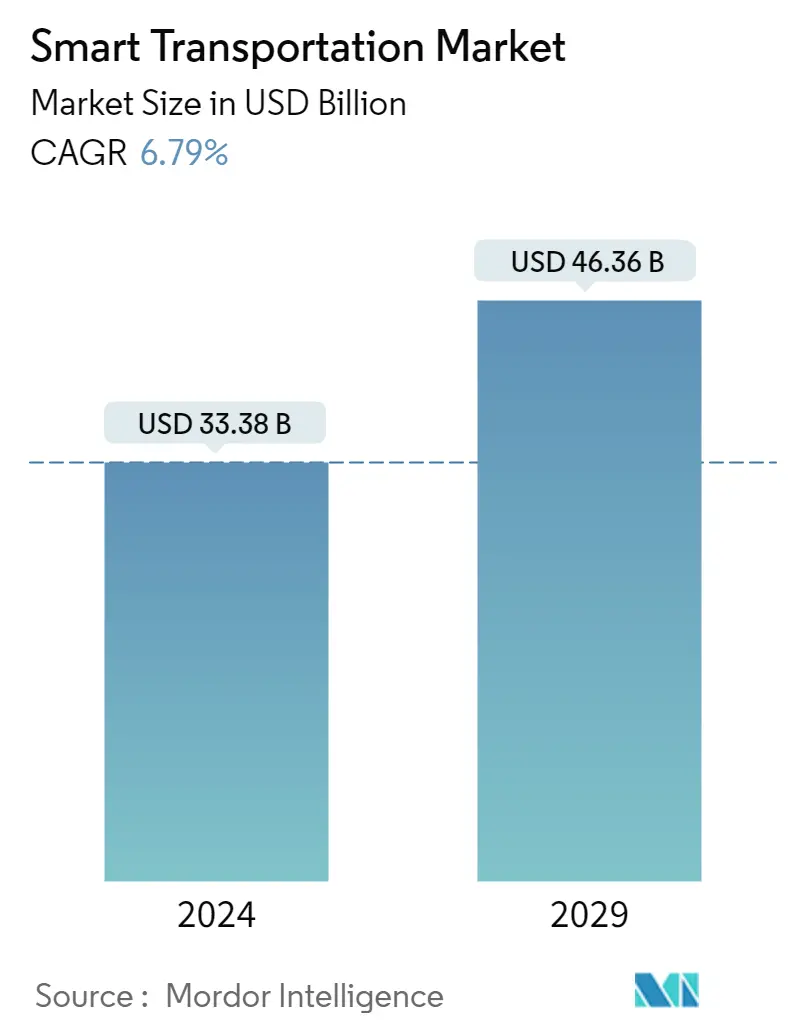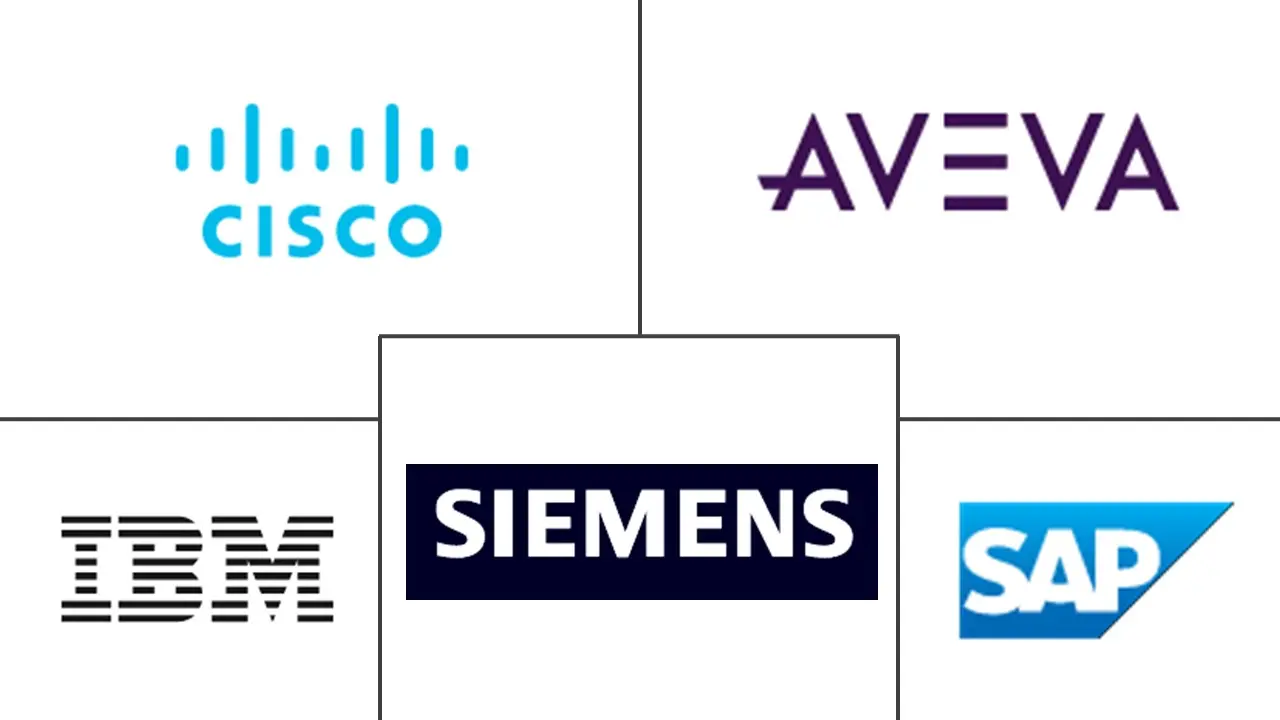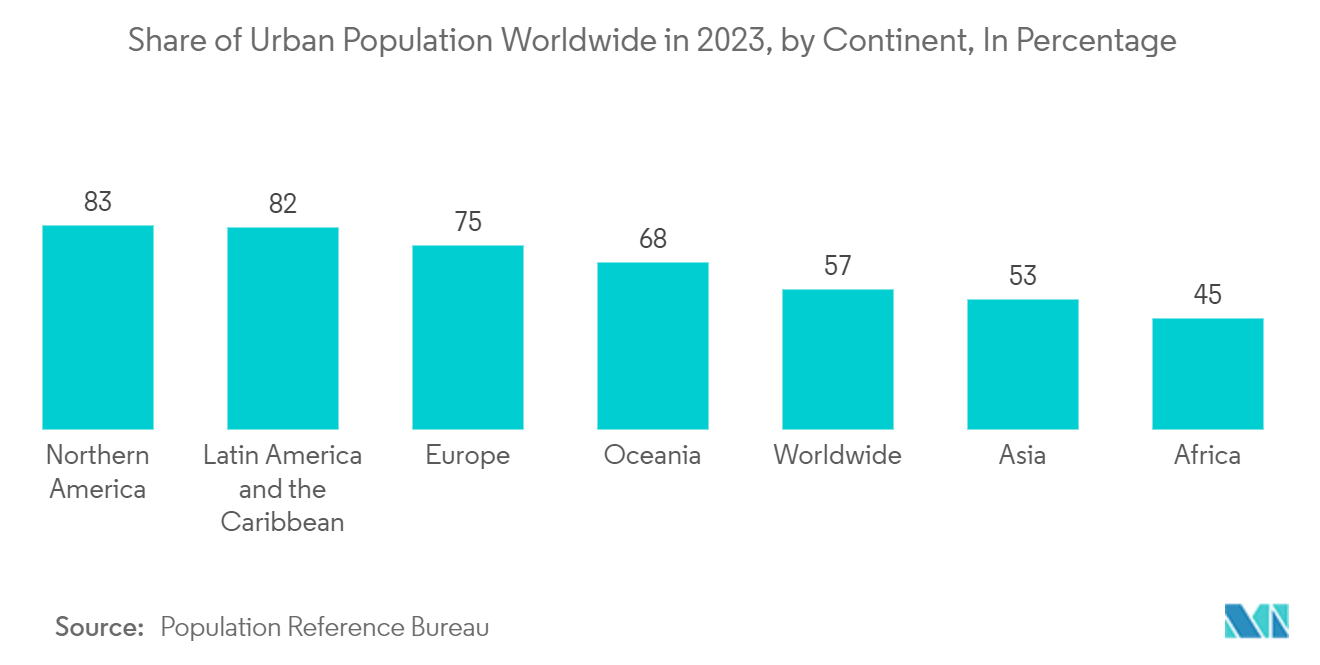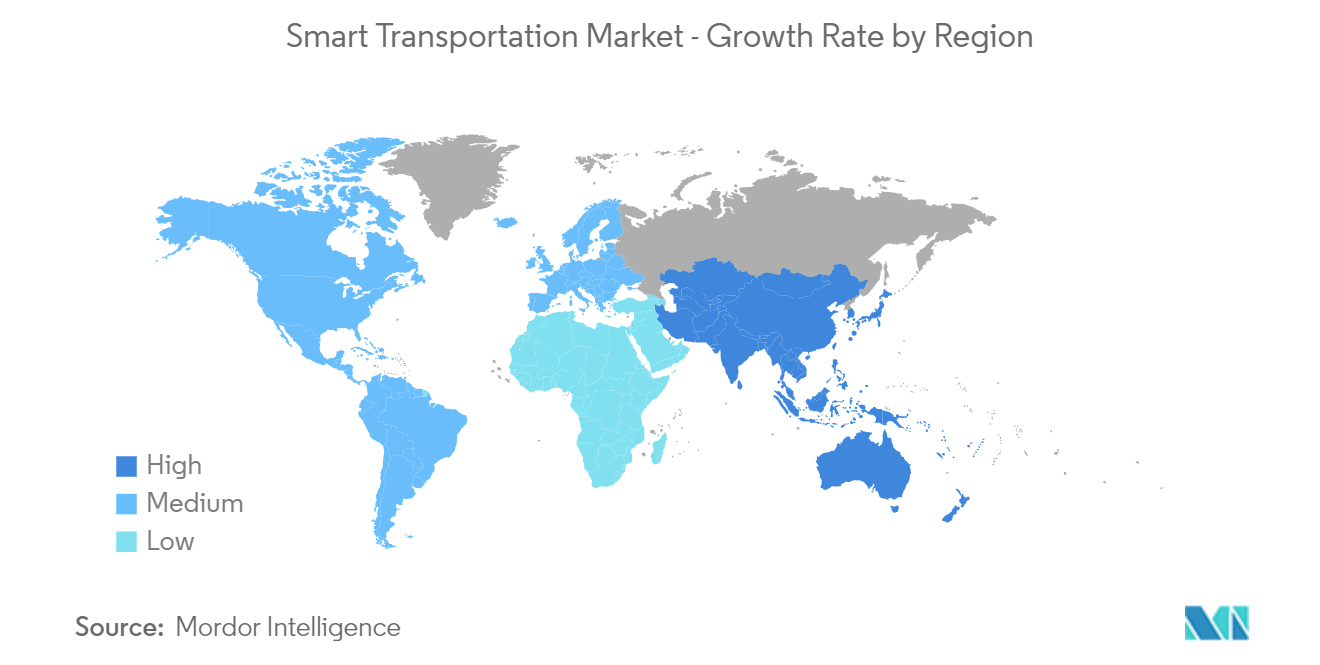Smart Transportation Market Size

| Study Period | 2019 - 2029 |
| Market Size (2024) | USD 33.38 Billion |
| Market Size (2029) | USD 46.36 Billion |
| CAGR (2024 - 2029) | 6.79 % |
| Fastest Growing Market | Asia Pacific |
| Largest Market | Europe |
Major Players
*Disclaimer: Major Players sorted in no particular order |
Smart Transportation Market Analysis
The Smart Transportation Market size is estimated at USD 33.38 billion in 2024, and is expected to reach USD 46.36 billion by 2029, growing at a CAGR of 6.79% during the forecast period (2024-2029).
Increasing traffic volume, government initiatives aimed at decreasing the effects of greenhouse emissions, rising city projects, and the rise of megacities, urbanization, and population are some factors driving the market growth. The UN forecasts estimate that more than 70% of the world population will be urbanized by 2030, wherein 700 million people will reside in cities in India. These predictions serve as a unique opportunity to plan, design, and build an ecologically and economically sustainable new India. Additionally, urbanization has boosted national economies across the globe, as 75% of global economic production takes place in the cities.
- Increasing urbanization reflects the growing complexities in cities worldwide, with transportation needs being one of them. One of the primary issues the transportation market faces is resolving this complexity. The trend of a rising number of IoT and linked devices will continue with smart city projects during the projection period. The increased use of linked products like smart homes, smart meters, smart transportation, and smart lighting, among others that use IoT to communicate with one another, is expected to drive market expansion. In addition, it is predicted that by 2025, there will be more than 26 smart cities, with the majority existing in North America and Europe, delivering a significant drive to AI and IoT technology for adoption in smart cities.
- One of the primary objectives of innovative city development is smart mobility, which includes transportation. Creating efficient, flexible, and integrated transportation networks is vital to smart mobility. Smart mobility is a significant development driver in modern urban centers and may improve tourists' and inhabitants' everyday lives. By 2040, cities are expected to accommodate 65% of the world's population.
- Healthy modes of transportation, such as walking and cycling, are prioritized in urban mobility management. Mobility management also minimizes carbon emissions and provides communities with optimal traffic flow analysis.
- Traffic congestion is increasing due to exponential growth in suburban and rural populations relocating to cities and an equivalent increase in population concentration around metropolitan centers. Vehicle congestion in cities has increased as cities have grown in density, assisted by insufficient roadway designs and bad urban planning. For example, in 2022, the average American motorist wasted 51 hours in traffic congestion, or approximately an hour each week. This is 15 hours longer lost to traffic than previously, and all that time squandered in traffic jams costs the typical American motorist USD 869 in lost time, according to the mobility analytics firm Inrix's 2022 Global Traffic Scorecard.
- Further, in April 2022, the Ministry of Electronics and Information Technology (MeitY) launched several applications under the Intelligent Transportation System (ITS) as part of the InTranSE- II program to improve India's traffic scenario. An indigenous Onboard Driver Assistance and Warning System (ODAWS), Bus Signal Priority System, and Common SMart IoT Connectiv (CoSMiC) software were designed as a joint enterprise by the Centre for Development of Advanced Computing (CDAC) and the Indian Institute of Technology Madras (IIT-M). Mahindra and Mahindra was the industrial collaborator for the project. The government declared that ODAWS aims to improve the highway infrastructure as the number of vehicles and road speed has increased, exacerbating safety concerns.
- However, due to the need for a standardized strategy, smart transportation mixed with numerous aspects, such as software, hardware, and mobile network components, are produced by multiple manufacturers, resulting in compatibility concerns. Furthermore, communication protocols range significantly among nations, posing challenges for manufacturers in terms of worldwide acceptance of their products.
Smart Transportation Market Trends
Rise of Urbanization, and Population would Drive the Market
- The population growth, coupled with the increasing urbanization rate and megacities, is the primary factor driving the market. Moreover, as the population grows and urbanizes, many cities will face transportation challenges, thus driving the demand for smart transportation. For instance, according to the Population Reference Bureau, in 2022, the degree of urbanization worldwide was 57%. North America was the region with the highest level of urbanization, with over four-fifths of the population residing in urban areas.
- More than half the world's urban population resides in Asia, where some countries, like India and China, already have about a billion people living in cities alone. The other regions with relatively high urban populations are North America, Europe, and Africa. Increasing urbanization indicates the rising complexities in the transportation of cities worldwide. Resolving these complexities is one of the significant challenges faced by the transport markets across these areas. For instance, according to the United Nations, people living in urban areas are expected to reach 68% by 2050.
- Urban population growth will significantly pressure public transport infrastructure. Residents of big cities will expect public transport that is fast, efficient, affordable, safe, and environmentally friendly. Delivering such transportation infrastructure will be one of the critical challenges confronting future cities. Furthermore, rapid urbanization has brought heavy traffic congestion, serious safety issues, and growing urban inequality. Smart transportation solutions have gained significant traction in the past few years across many highly urbanized cities to overcome such challenges by delivering real-time travel and traffic information with resilient network control.
- Furthermore, besides increasing traffic congestion, the urban areas and megacities face several other transport-related problems, such as growing emissions of pollutants and depleting fuel resources that adversely impact the overall well-being of any major city. To make transport management more effective, several cities worldwide are trying to create intelligence into existing systems by adopting smart transportation systems, which is expected to drive the market's growth at a rapid pace.
- Moreover, urban transportation is becoming crucial for a better quality of life for citizens in any city. Today cities worldwide are expanding to incredible sizes. The rising maturation rate of megacities worldwide and multiple innovations taking place in the technology field for the transportation sector are further driving the market's growth.

Asia Pacific is Expected to Register Fastest Growth
- China outlined a recent comprehensive transportation system in the 14th Five-Year Plan (2021-2025). According to the circular, by 2025, China will have made achievements in pursuing intelligent and green transportation, as well as significant advances in overall competence, service quality, and efficiency of the transportation industry. This plan aims to improve the transportation industry's roads, trains, ports, and waterways and the technology and human resources involved. As a result, this will support growth in urbanization, consumer demand, and factor supply movements.
- Smart transportation is quickly expanding in Japan with the introduction of smart transportation networks, such as the Internet of Things (IoT). Smart transportation networks require IoT architecture, which includes technologies such as the cloud, sensors, and data communication. Rapid improvements in recent years have made it feasible to enhance device communication.
- Australia has been developing traffic management technologies interacting with drivers and infrastructure operators to reduce traffic congestion and enhance safety and traffic conditions. The country has a diverse and complex transportation infrastructure network, creating an opportunity for the market players in the country due to the increasing demand for smart transportation technologies.
- The rest of Asia-Pacific consists of many emerging countries, including Singapore, India, and South Korea. The emergence of smart cities in these countries is increasing the adoption of intelligent technologies in transportation to enhance traffic efficiencies, creating a market opportunity for technology providers.
- Countries in the region are also helping each other by investing and partnering in the market adoption in Asia-Pacific. For instance, in December 2022, India and South Korea agreed to a loan of INR 1,495 crore (USD 183.14 million) from the Economic Development Cooperation Fund (EDCF) of the Republic of Korea to construct an intelligent transport system on the Nagpur-Mumbai Expressway.

Smart Transportation Industry Overview
As the market penetration of the smart transportation industry is relatively low, firms are poised to offer products and solutions that are tailor-made to specific segments and even customize products for individual customers, enhancing differentiation and price realization. The major participants in the smart transportation business, like Cisco, SAP SE, IBM, etc., are focusing on growing their operations in new areas. These companies have a track history of developing novel and inventive ideas to expand their product lines in the smart transportation sector. Overall, the industry's intensity of competitive rivalry is expected to be high during the forecast period.
- August 2023 - Hitachi Rail’s world-first digital transport app enters full commercial service to connect Genoa’s entire public transport infrastructure, The service, in conjunction with the city's public and private transport systems, allows any person living or visiting Genoa to plan, book and pay for multimodal journeys at a reduced price. By integrating the city's public and private transport systems, the service provides users with the possibility to plan, book and pay for multimodal journeys. 663 buses, 2500 bus stops and the metro line uses 15 million passengers per annum.
- October 2022 - Siemens and 16 partners started a project likely to last through the end of 2024 to enhance artificial intelligence in the autonomous operation of regional trains. A budget of EUR 23 million (USD 25 million) within the German government-funded "safe.trAIn" project is available for this project. Meeting the requirements in this highly governed and standardized environment can significantly improve the efficiency and sustainability of regional railway transportation.
Smart Transportation Market Leaders
-
Cisco Systems Inc.
-
SAP SE
-
IBM Corporation
-
AVEVA Group PLC
-
Siemens Corporation
*Disclaimer: Major Players sorted in no particular order

Smart Transportation Market News
- November 2023 – Hitachi ZeroCarbon Ltd. has partnered with FirstGroup plc to lead the UK's shift to electric buses. The collaboration, which is part of FirstGroup's bus fleet and infrastructure decarbonisation programme, will provide batteries for First Bus's expanding electric bus fleet, helping to make a positive impact on air quality, tackle congestion and improve customer experience.
- August 2023 - NEC India partners with Mowasalat for smart transportation in Qatar, Enabling travel solutions to people attending tournament in Qatar, the implementation of ITMS for Tournament Bus Service (TBS), and help enable best-in-class public transportation experience to millions of Football admirers from all over the world.
Smart Transportation Market Report - Table of Contents
1. INTRODUCTION
- 1.1 Study Assumptions and Market Definition
- 1.2 Scope of the Study
2. RESEARCH METHODOLOGY
3. EXECUTIVE SUMMARY
4. MARKET INSIGHTS
- 4.1 Market Overview
-
4.2 Industry Attractiveness - Porter's Five Forces Analysis
- 4.2.1 Bargaining Power of Suppliers
- 4.2.2 Bargaining Power of Buyers
- 4.2.3 Threat of New Entrants
- 4.2.4 Intensity of Competitive Rivalry
- 4.2.5 Threat of Substitute Products
- 4.3 Industry Value Chain Analysis
- 4.4 Impact of Macroeconomic Trends on the Market
- 4.5 Technology Snapshot
5. MARKET DYNAMICS
-
5.1 Market Drivers
- 5.1.1 Rise of Urbanization and Increasing Mega Cities and Increasing Population
- 5.1.2 Government Initiatives to Enhance the Transportation Infrastructure
-
5.2 Market Restraints
- 5.2.1 High Capital Required for Deployment
6. MARKET SEGMENTATION
-
6.1 By Application
- 6.1.1 Traffic Management
- 6.1.2 Road Safety and Security
- 6.1.3 Parking Management
- 6.1.4 Public Transport
- 6.1.5 Automotive Telematics
- 6.1.6 Freight
- 6.1.7 Other Applications
-
6.2 By Product Type
- 6.2.1 Advanced Traveler Information Systems (ATIS)
- 6.2.2 Advanced Transportation Management Systems (ATMS)
- 6.2.3 Advanced Transportation Pricing Systems (ATPS)
- 6.2.4 Advanced Public Transportation Systems (APTS)
- 6.2.5 Cooperative Vehicle Systems
-
6.3 By Geography***
- 6.3.1 North America
- 6.3.1.1 United States
- 6.3.1.2 Canada
- 6.3.2 Europe
- 6.3.2.1 United Kingdom
- 6.3.2.2 Germany
- 6.3.2.3 France
- 6.3.3 Asia
- 6.3.3.1 China
- 6.3.3.2 Japan
- 6.3.4 Australia and New Zealand
- 6.3.5 Latin America
- 6.3.5.1 Mexico
- 6.3.5.2 Brazil
- 6.3.6 Middle East and Africa
- 6.3.6.1 United Arab Emirates
- 6.3.6.2 South Africa
- 6.3.6.3 Saudi Arabia
7. COMPETITIVE LANDSCAPE
-
7.1 Company Profiles*
- 7.1.1 Cisco Systems Inc.
- 7.1.2 SAP SE
- 7.1.3 IBM Corporation
- 7.1.4 AVEVA Group PLC
- 7.1.5 Siemens Corporation
- 7.1.6 Oracle Corporation
- 7.1.7 Alstom
- 7.1.8 Advantech Co. Ltd
- 7.1.9 Orange SA
- 7.1.10 Huawei Technologies Co. Ltd
- 7.1.11 Hitachi Ltd
8. INVESTMENT ANALYSIS
9. FUTURE OF THE MARKET
** Subject To AvailablitySmart Transportation Industry Segmentation
Smart transport or intelligent transport is an advanced transportation infrastructure that aims to provide innovative traveler information systems, transportation management systems, transportation pricing systems, public transportation systems, and cooperative vehicle systems. It has various applications, such as traffic management, safety and security, parking management, public transport, automotive telematics, and freight.
The study also tracks the demand for the global smart transportation market based on application, product type in multiple geographies. The impact of macroeconomic trends on the market is also covered under the scope of the study. Further, the disturbance of the factors affecting the Market's evolution in the near future has been covered in the study regarding drivers and constraints. The market sizes and predictions are provided in terms of value in USD for all the above segments.
| By Application | Traffic Management | |
| Road Safety and Security | ||
| Parking Management | ||
| Public Transport | ||
| Automotive Telematics | ||
| Freight | ||
| Other Applications | ||
| By Product Type | Advanced Traveler Information Systems (ATIS) | |
| Advanced Transportation Management Systems (ATMS) | ||
| Advanced Transportation Pricing Systems (ATPS) | ||
| Advanced Public Transportation Systems (APTS) | ||
| Cooperative Vehicle Systems | ||
| By Geography*** | North America | United States |
| Canada | ||
| By Geography*** | Europe | United Kingdom |
| Germany | ||
| France | ||
| By Geography*** | Asia | China |
| Japan | ||
| By Geography*** | Australia and New Zealand | |
| Latin America | Mexico | |
| Brazil | ||
| Middle East and Africa | United Arab Emirates | |
| South Africa | ||
| Saudi Arabia |
Smart Transportation Market Research FAQs
How big is the Smart Transportation Market?
The Smart Transportation Market size is expected to reach USD 33.38 billion in 2024 and grow at a CAGR of 6.79% to reach USD 46.36 billion by 2029.
What is the current Smart Transportation Market size?
In 2024, the Smart Transportation Market size is expected to reach USD 33.38 billion.
Who are the key players in Smart Transportation Market?
Cisco Systems Inc., SAP SE, IBM Corporation, AVEVA Group PLC and Siemens Corporation are the major companies operating in the Smart Transportation Market.
Which is the fastest growing region in Smart Transportation Market?
Asia Pacific is estimated to grow at the highest CAGR over the forecast period (2024-2029).
Which region has the biggest share in Smart Transportation Market?
In 2024, the Europe accounts for the largest market share in Smart Transportation Market.
What years does this Smart Transportation Market cover, and what was the market size in 2023?
In 2023, the Smart Transportation Market size was estimated at USD 31.11 billion. The report covers the Smart Transportation Market historical market size for years: 2019, 2020, 2021, 2022 and 2023. The report also forecasts the Smart Transportation Market size for years: 2024, 2025, 2026, 2027, 2028 and 2029.
Smart Mobility Industry Report
Statistics for the 2023 Smart Mobility market share, size and revenue growth rate, created by Mordor Intelligence™ Industry Reports. Smart Mobility analysis includes a market forecast outlook to 2029 and historical overview. Get a sample of this industry analysis as a free report PDF download.



